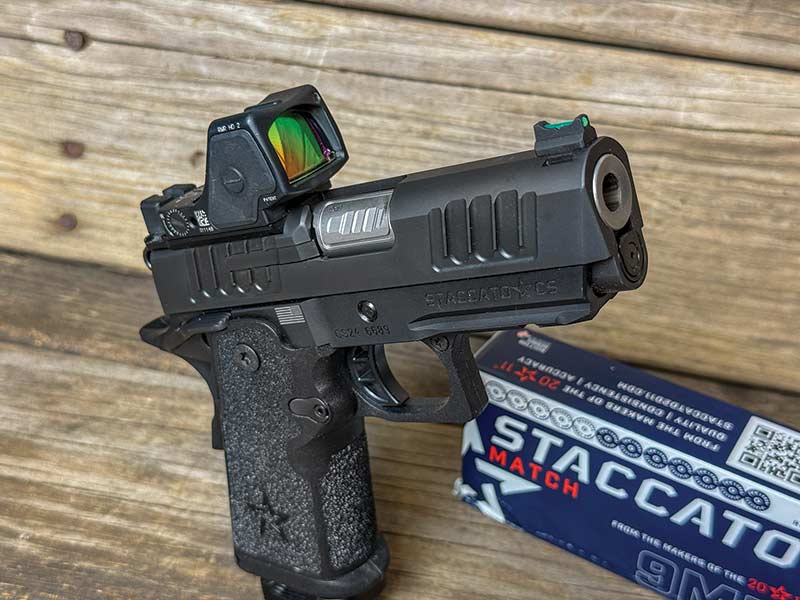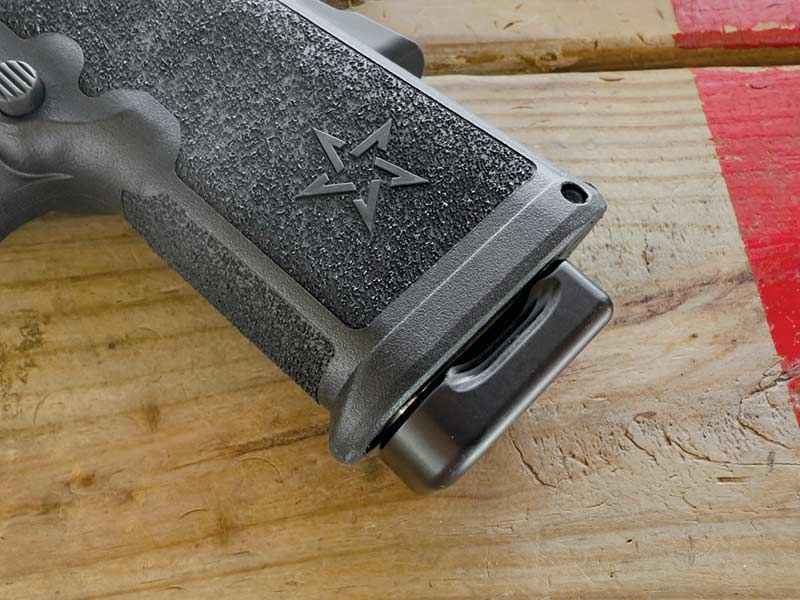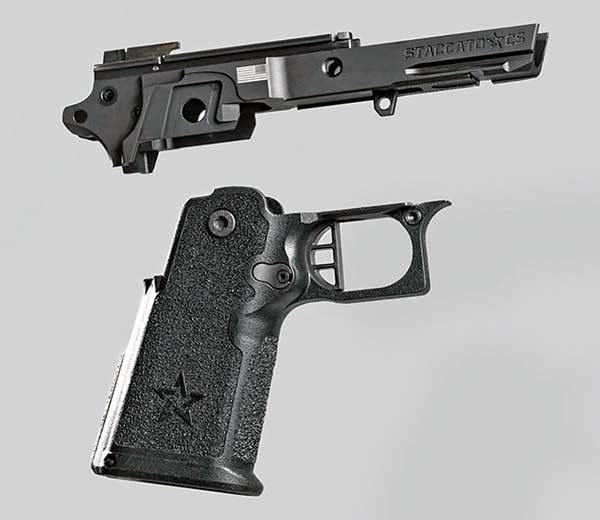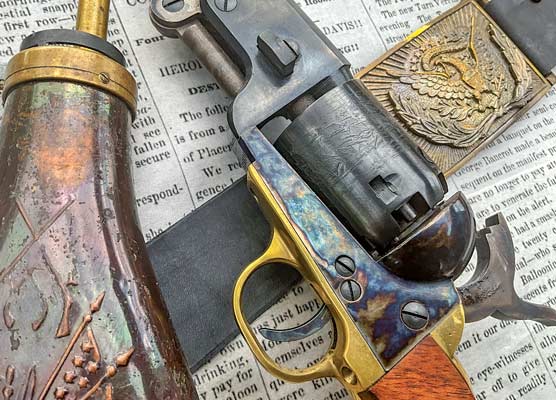Staccato 2011 CS Pistol
Portable Precision
Consistency and predictability can be wonderful things. Take, for instance, dinner and supper, or as we call it here, dunnah and suppah. Be sure to emphasize and go low for the “dun” and “sup” and draw and fade on the “ah” when you say that, and you’ll have it about right. For those of you who don’t dine wearing bow ties, these mysterious terms translate to dinner and lunch.
Because the science is settled on this, we know that during dunnah and suppah, you stick to the same segment of food when you eat. For example, civilized people take bites of meat only, or at least until inspiration strikes to shift to mashed potatoes and gravy. At that point, subsequent bites consist only of taters. Vegetables are fine, too, provided you eat them independently of the other foods on the plate. The important part of the process is not to mix any of these things in a single bite. It’s like that warning in Ghostbusters about crossing the streams. It’s not only heresy but illegal in 34 states. If you do this, you will die, and Taylor Swift will lip-synch Polka, Polka, Polka at your funeral. #Fact. The fact these things mix together in your guts in a minute or two is irrelevant, again, as proven by the settled science.
I have always wondered why those plates with divided sections are almost always targeted at kids. They’re really more appropriate for refined adults like yours truly. At least prisons and military mess halls seem to have gotten the divided trays thing mostly right. But I digress. The real point here is that consistency and predictability are nifty for handguns, too.
Big And Small
Since we all agree consistency is a good thing (and since it’s an ugly election season and I’m feeling gracious, I’ll overlook any disagreement on this), doesn’t it make sense to seek congruence in large and small guns? If you have something larger for the home or range, why not pursue a smaller version of the same for carry? If you’re to rely on multiple guns for your comprehensive defense strategy, doesn’t it make sense they should operate identically?
Because I’ll never oppose an open logic gate allowing me to justify obtaining another gun, I’ll vote … yes!
It’s no secret that I’ve been using a full-size 2011 pistol — a Staccato P model, both for carrying and within arms’ reach at night. But as much as I rant about the fact we can all carry large guns if we want to, I’ll admit smaller is just more appealing on occasion. This led me on a quest to run the relatively new Staccato 2011 CS through its paces.
CS Compact Carry
If you could have identical twins separated by a couple of years, that would describe the P and CS model. The CS is a near-identical scaled-down version of its older sibling. Single action? Check. Double stack, ambidextrous safeties, forward cocking serrations, bull barrel and two-part metal and polymer frame? All check.
The big differences are dimensional and in weight. While the P model uses a steel and polymer frame, the CS relies on lighter aluminum paired with the polymer section, which, along with the reduced size, accounts for the lighter weight.
To provide a more meaningful picture of concealed carry impact, I’m comparing my own dimensions via the wooden ruler method. Overall length, as determined by the beavertail to muzzle, is right at 8″ for the P and 7″ for the CS. “Carry height” as measured by the base of the magazine to the top of the slide along the diagonal matching the grip angle is 6″ for the P and 5½” for the CS.
As for weight, loaded is all that really matters for a picture of what your day will look like, so out came the kitchen scale. Don’t tell my wife. The big P, loaded with 124-grain ammo, weighs in at 2 lbs., 13.8 oz. while the CS loaded similarly weighs 2 lbs., 2.7 oz.
Feel And Handling
The grip texture is different from that of my older P model. On the CS, it’s more like a sandpaper or skateboard tape texture molded into the polymer on both sides and the front and back straps. On the P model, it’s more of a coarser pattern of “v” or “checkmark” things that provide the grippy surface. Comparing the two, I like the skateboard tape feel as it seems to better cement my hand in place.
As for handling with respect to the more compact size, all firing hand fingers fit on the grip easily, with my pinkie resting on top of a discreet, molded-in flared magazine well.
Interestingly, the compact CS packs a wallop. While the P model holds 17+1, the CS only drops two total rounds with a capacity of 15 in its double-stack magazine. You can order a variant with a full-size grip holding 17 rounds. The CS’s grip looked a bit narrower to the naked eye, so I broke out the calipers. Sure enough, it’s a bit slimmer at 1.2″ vs. 1.3″.
Portable Performance
I’ve been shooting the CS with several types of ammo ranging in projectile weight from 65 to 136 grains. So far, after a few hundred rounds, I’ve experienced no failures to feed, eject or fire of any kind. Before the first range visit, I did field strip this pistol to see how it came apart and applied some Slip 2000 EWL to all the right spots. Unlike some previous Staccato 2011 models, this one, with its captive dual recoil spring assembly, requires no tools to field strip. After removing the slide by taking out the slide lock, the recoil spring assembly will drop out, complete with a plug on the fiery end that takes the place of a bushing with its bull barrel setup. Then, the barrel will slide out the front, and you’re ready for maintenance.
The Black Hills 115-grain JHP load clocked in a 1,134.8 fps and printed a five-shot, 25-yard group of 2.1″. Sellier & Bellot all-copper 100-grain hollowpoints averaged 1,246 fps and printed a 2.4″ group. Norma NXD 65-grain non-expanding defensive ammo (think fluid displacement bullet design) broke the sound barrier easily at 1,730.5 fps and printed a 1.3″ group. Last but not least, Staccato’s own 136-grain Match ammo averaged 916.7 fps and printed an average of 1.3″ groups.
Like other models, you can order the CS as optics-ready or not. I configured this one with a new Trijicon RMR HD, so a shorter sight radius didn’t impact sighting ability when testing for accuracy. I also found the Dawson Precision optics plates and rear sight co-witnessed perfectly in the lower 10% of the optic window.
Another high-quality offering from the folks with the race gun heritage. They’re not inexpensive, with a base MSRP of $2,499, but more in line with more traditional custom 1911s.
For more info: Staccato2011.com












